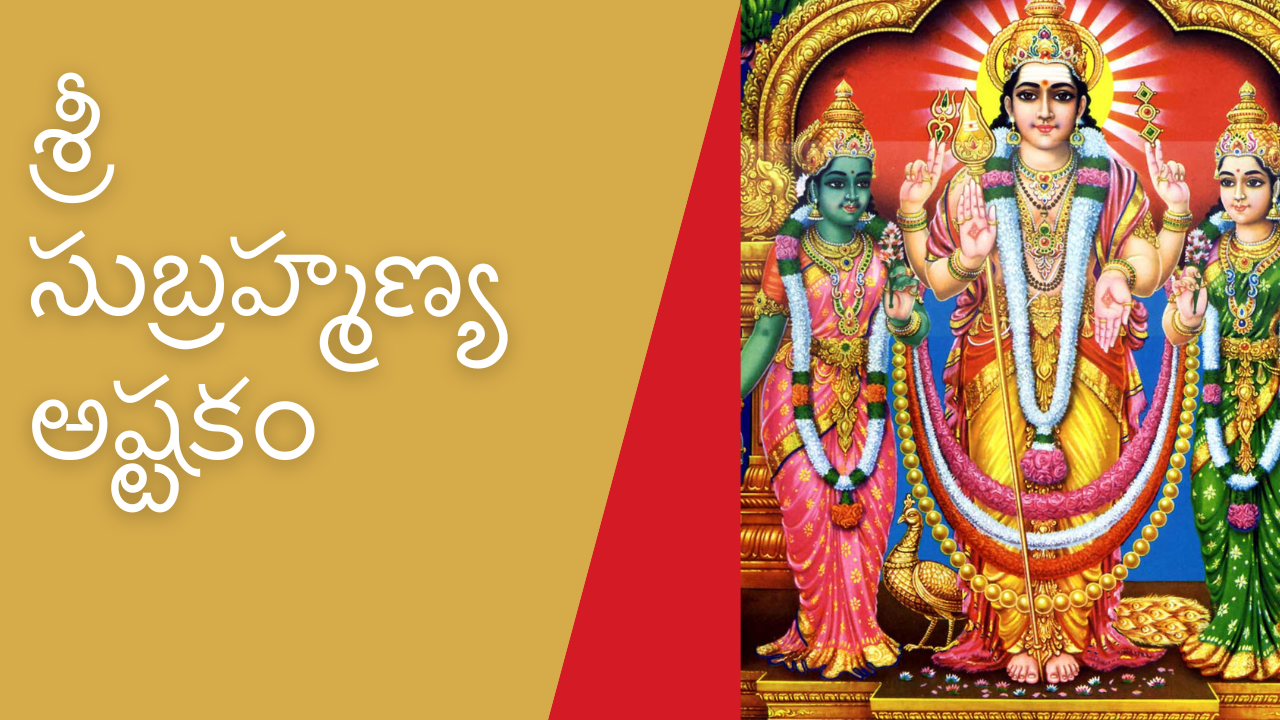Subramanya Ashtakam in Telugu : Subramanya Ashtakam, a revered hymn in Hindu spirituality, holds profound significance for devotees of Lord Subramanya.
శ్రీ సుబ్రహ్మణ్య అష్టకం
హే స్వామినాథ కరుణాకర దీనబంధో,
శ్రీపార్వతీశముఖపంకజ పద్మబంధో ।
శ్రీశాదిదేవగణపూజితపాదపద్మ,
వల్లీసనాథ మమ దేహి కరావలంబమ్ ॥ 1 ॥
దేవాదిదేవనుత దేవగణాధినాథ,
దేవేంద్రవంద్య మృదుపంకజమంజుపాద ।
దేవర్షినారదమునీంద్రసుగీతకీర్తే,
వల్లీసనాథ మమ దేహి కరావలంబమ్ ॥ 2 ॥
నిత్యాన్నదాన నిరతాఖిల రోగహారిన్,
తస్మాత్ప్రదాన పరిపూరితభక్తకామ ।
శృత్యాగమప్రణవవాచ్యనిజస్వరూప,
వల్లీసనాథ మమ దేహి కరావలంబమ్ ॥ 3 ॥
క్రౌంచాసురేంద్ర పరిఖండన శక్తిశూల,
పాశాదిశస్త్రపరిమండితదివ్యపాణే ।
శ్రీకుండలీశ ధృతతుండ శిఖీంద్రవాహ,
వల్లీసనాథ మమ దేహి కరావలంబమ్ ॥ 4 ॥
దేవాదిదేవ రథమండల మధ్య వేద్య,
దేవేంద్ర పీఠనగరం దృఢచాపహస్తమ్ ।
శూరం నిహత్య సురకోటిభిరీడ్యమాన,
వల్లీసనాథ మమ దేహి కరావలంబమ్ ॥ 5 ॥
హారాదిరత్నమణియుక్తకిరీటహార,
కేయూరకుండలలసత్కవచాభిరామ ।
హే వీర తారక జయాఽమరబృందవంద్య,
వల్లీసనాథ మమ దేహి కరావలంబమ్ ॥ 6 ॥
పంచాక్షరాదిమనుమంత్రిత గాంగతోయైః,
పంచామృతైః ప్రముదితేంద్రముఖైర్మునీంద్రైః ।
పట్టాభిషిక్త హరియుక్త పరాసనాథ,
వల్లీసనాథ మమ దేహి కరావలంబమ్ ॥ 7 ॥
శ్రీకార్తికేయ కరుణామృతపూర్ణదృష్ట్యా,
కామాదిరోగకలుషీకృతదుష్టచిత్తమ్ ।
భక్త్వా తు మామవకళాధర కాంతికాంత్యా,
వల్లీసనాథ మమ దేహి కరావలంబమ్ ॥ 8 ॥
సుబ్రహ్మణ్య కరావలంబం పుణ్యం యే పఠంతి ద్విజోత్తమాః ।
తే సర్వే ముక్తి మాయాంతి సుబ్రహ్మణ్య ప్రసాదతః ।
సుబ్రహ్మణ్య కరావలంబమిదం ప్రాతరుత్థాయ యః పఠేత్ ।
కోటిజన్మకృతం పాపం తత్క్షణాదేవ నశ్యతి ॥

Table of Contents
Subramanya Ashtakam in Telugu: Unveiling the Divine Hymn
Introduction
Subramanya Ashtakam, a revered hymn in Hindu spirituality, holds profound significance for devotees of Lord Subramanya. Composed in Telugu, this hymn glorifies the attributes and powers of Lord Subramanya, also known as Kartikeya or Murugan. Each verse resonates with devotion and portrays the divine qualities of the deity, invoking blessings and protection upon those who chant it with sincerity.
Understanding Subramanya Ashtakam
1. What is Subramanya Ashtakam?
Subramanya Ashtakam is an octet (ashtakam) consisting of eight verses dedicated to Lord Subramanya. These verses are crafted to capture the essence of the deity’s prowess, wisdom, and grace. The hymn is often recited during prayers and rituals dedicated to Lord Subramanya, especially in regions where Telugu is spoken widely, such as Andhra Pradesh and Telangana.
2. Who composed Subramanya Ashtakam?
The authorship of Subramanya Ashtakam is attributed to the legendary Hindu philosopher and saint Sri Adi Shankaracharya. Known for his prolific contributions to Hindu scriptures and hymns, Shankaracharya composed this hymn to extol the virtues of Lord Subramanya and to invoke blessings upon his devotees.
3. What are the main themes of Subramanya Ashtakam?
The hymn primarily focuses on praising Lord Subramanya’s divine attributes, including his valor, compassion, wisdom, and ability to dispel ignorance. It highlights his role as the commander of celestial armies and the remover of obstacles, making him a beloved deity among devotees seeking protection and guidance.
Significance and Benefits of Chanting Subramanya Ashtakam
1. Spiritual Benefits:
Chanting Subramanya Ashtakam is believed to bestow spiritual benefits such as inner peace, clarity of mind, and protection from negative influences. The hymn acts as a powerful mantra that resonates with the divine energy of Lord Subramanya, promoting spiritual growth and well-being.
2. Protection and Blessings:
Devotees often recite Subramanya Ashtakam to seek the deity’s blessings for overcoming challenges and obstacles in life. It is believed that regular chanting of these verses can create a shield of divine protection around the devotee, guarding them from harm and guiding them on the path of righteousness.
3. Cultural and Linguistic Significance:
Written in Telugu, Subramanya Ashtakam holds cultural significance in the Telugu-speaking regions of India. It not only preserves the rich heritage of the Telugu language but also serves as a medium through which devotees can express their devotion and reverence towards Lord Subramanya in their native tongue.
FAQs about Subramanya Ashtakam
How can I learn to chant Subramanya Ashtakam in Telugu?
Learning to chant Subramanya Ashtakam in Telugu requires access to the text of the hymn along with its pronunciation guide. One can find resources such as religious texts, online videos, or guidance from knowledgeable individuals who can help in learning the correct intonation and rhythm of the verses.
Is there a specific time or occasion to chant Subramanya Ashtakam?
While there is no specific restriction, chanting Subramanya Ashtakam in Telugu is often performed during morning prayers or as part of special rituals dedicated to Lord Subramanya. Many devotees also recite it on Tuesdays, which is considered auspicious for worshipping Lord Subramanya.
What are the benefits of chanting Subramanya Ashtakam regularly?
Regular chanting of Subramanya Ashtakam in Telugu is believed to confer various benefits, including spiritual upliftment, protection from adversities, and blessings for overall well-being. It is said to enhance mental clarity, promote positivity, and strengthen one’s connection with the divine.
Conclusion
Subramanya Ashtakam in Telugu stands as a timeless testament to the glory and magnificence of Lord Subramanya, cherished by devotees across generations. In the serene verses of Telugu, the hymn not only articulates divine attributes but also fosters a deep spiritual connection with the deity. By chanting Subramanya Ashtakam in Telugu with reverence and devotion, devotees invite the blessings and grace of Lord Subramanya into their lives, finding solace and strength in his divine presence. As you delve into the verses of this hymn, may you experience the transformative power of devotion and the profound spirituality it brings forth.
In essence, Subramanya Ashtakam in Telugu encapsulates the essence of devotion, spirituality, and cultural heritage, resonating with the hearts of millions who seek solace and guidance from Lord Subramanya, the beloved deity of wisdom and valor.























